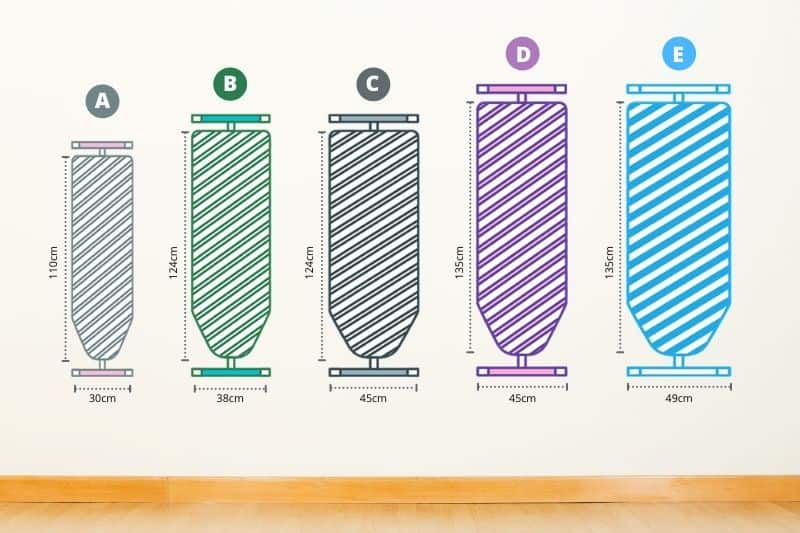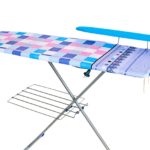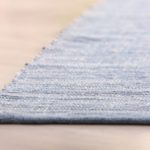If you’re about to buy your very first ironing board you might be wondering what size board to buy.
It can be difficult to iron out all the information. But don’t need to look any further than this guide! The answers lie within…
Read on to find out all the details.
Ironing Board Sizes in the UK
There are five standard ironing board sizes in the UK:
- Size A: 110 x 30 cm
- Size B: 124 x 38 cm
- Size C: 124 x 45 cm
- Size D: 135 x 45 cm
- Size E: 135 x 49 cm
(There can sometimes be small variations in sizes between manufacturers.)
The first and larger number represents the length of the board, and the second and smaller number is the width of the ironing board.
Size A is the smallest standard ironing board you can buy in the UK. Size E, on the other hand, is the largest standard ironing board you can buy in the UK.
Size A ironing boards are suitable for smaller, not-so-heavy-duty ironing sessions. As you work down the list the boards get bigger. The bigger the size the better it will be at ironing larger items. For example, Size E would be an excellent size ironing board to iron bed sheets on.
But what does all of this mean? Read on to find out.
Choosing the Right Ironing Board
So, you’ve now got a pretty good idea of what size ironing boards you can buy. But, how do you know which board is for you? Easy, just follow these steps:
1. What will you be ironing?
The first step in choosing an ironing board is to think about what clothes and items you plan on ironing.
Why is this important? I hear you say.
It’s important because if you only plan on ironing small items, say t-shirts and shorts, you don’t actually need to purchase a massive ironing board. An A, B or C sized ironing board would be big enough for you.
Not buying such a big ironing board would also save you space, money and you can pick up a lighter board for yourself.
On the other hand, if you want to do a lot of heavy-duty ironing, you’ll need a bigger, if not the biggest size ironing board, to achieve your goal. (E).
2. Where will you be ironing?
Once you know roughly what you plan on ironing, the next thing you need to establish is where you’ll be doing your ironing.
For me personally, I iron in the kitchen, it’s a fairly big space, so I could use the largest ironing board on the market if I wanted to. (I actually use a smaller ironing board because it’s easier to transport around the house!)
But not everyone has lots of space. So, it’s better to think about ironing in the roomiest room in the house.
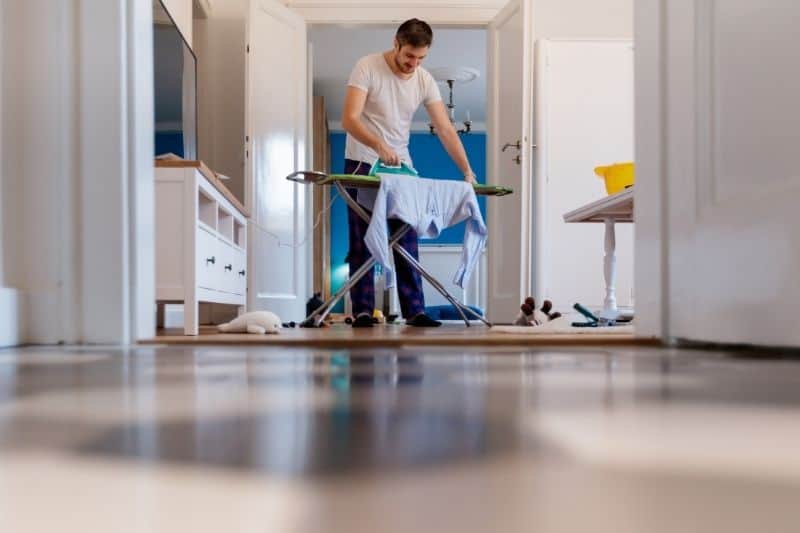
For example, if you don’t have a large area free in your kitchen and you plan on ironing in your living room, you need to think about how much space you’re going to need.
And I don’t just mean space for when the ironing board is set up. You must consider what it’ll be like to carry the ironing board through your living room. Are you at risk of knocking over a lamp or the TV, for example?
If these are things that could happen, then you need to think about buying a smaller size ironing board, so that you can limit the potential damage to your home.
Further to this, you need to consider how much space you have in the area you plan to iron in.
What I mean by this is, it’s all well and good getting an ironing board that fits into your room, but if you can’t move around the board, or you can’t reach your pile of clothes, then ironing in these conditions isn’t going to be pleasant for you.
When you iron, you do have to have space to move around, whether it’s around the board or to get to the clothes. You don’t want to end up buying an ironing board that is so big, you don’t have space to work in. This environment can become claustrophobic and very frustrating.
3. Where will you store the ironing board?
Not everyone likes to iron and lots of people put off doing the ironing for weeks on end. So, if you’re not going to be using the ironing board, you’ve got to think about where you’re going to store it.
Ironing boards are heavy and they hurt a lot(!) when they fall on you, so storing them somewhere safe is essential.
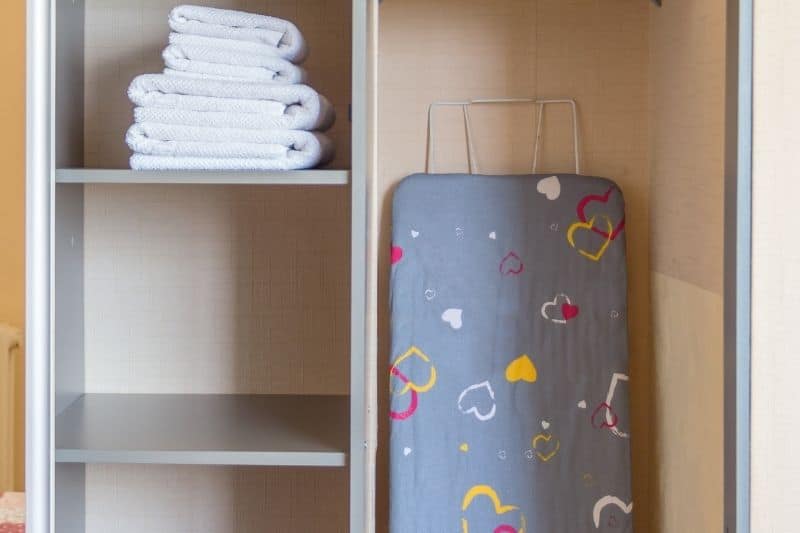
If you plan on doing your ironing every few weeks, then you could probably find a cupboard to stick your ironing board into when you’re not using it.
Or, some people put their ironing board behind their sofa – not such a good idea if you have kids/pets that are likely to go behind the sofa to play.
On the flip side, some people like to iron every day, so it would be worth storing the ironing board somewhere safe, yet very accessible.
Remember my point above too, you should store your ironing board near to where you plan on doing your ironing, so you don’t have to ferry the board back and forth a lot.
4. Measure out the space
When you’re done debating over what you’ll be ironing, where you’ll be ironing, and where the ironing board could be stored, the last but one thing that must be done is to measure the ‘potential ironing area’ out.
For example, if you plan on ironing medium-sized goods, a Size C or D ironing board would be good for you.
You need to go to your kitchen, the ‘potential ironing area’, and measure out the lengths noted above to see if you have enough space to move the board around and to assemble it. You then need to measure the storage spot you intend to use.
If you do have enough room and everything works out okay, you know what size ironing board to get.
On the other hand, if you’ve measured and you don’t think there’s enough room you need to reconsider your answer to the questions above.
5. Sockets
The final thing you should always do is to check that you have a plug socket nearby.
You can tick all of the boxes above, yet if you’re not actually near an electricity point everything’ll come to a standstill.
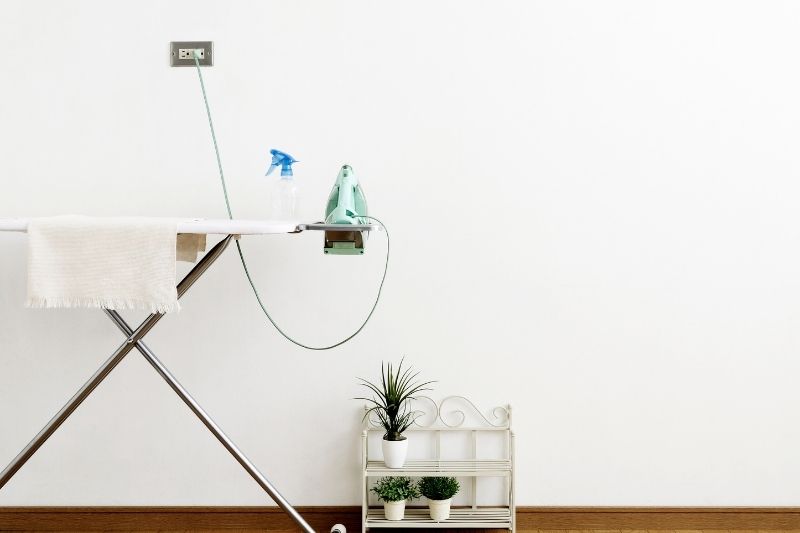
You obviously do have the option of using an extension cable, I have done this myself. But you do run the risk of tripping over even more leads.
If you need to run more power cables throughout your house, you should try sticking the cables down with some tape, so that you, or someone else, don’t trip over them.
Other Things to Consider
Weight
It’ll be difficult to guess how heavy an ironing board will be without actually trying to lift it up. So, if you can go to a shop to test the various weights of the ironing boards you fancy, you should go.
A quick trip like this can show you almost instantly if you’re going to struggle to carry the board or not. Plus, now is a good time to reconsider where the board will be stored in your house.
You really don’t want to go dragging a heavy board around the house!
Further to this, you often find that lightweight ironing boards can feel a little flimsy and they don’t have the best balance. Heavier ironing boards, on the other hand, are typically more stable.
But you should always pick an ironing board that suits you.
Height
The height of your ironing board is extremely important! After all, you don’t want to be hunched over a board that is too small for you for hours. Comfort is key.
The majority of ironing boards come with a height adjuster, so you can pick a suitable height for yourself. However, there are some ironing boards that come at a set height.
It’s important that you read what height your ironing board will be before you buy it.
Alternatives
Not everyone wants a traditional ironing board in their home, but luckily enough there are alternatives to be had.
These alternatives include:
Table-top ironing boards
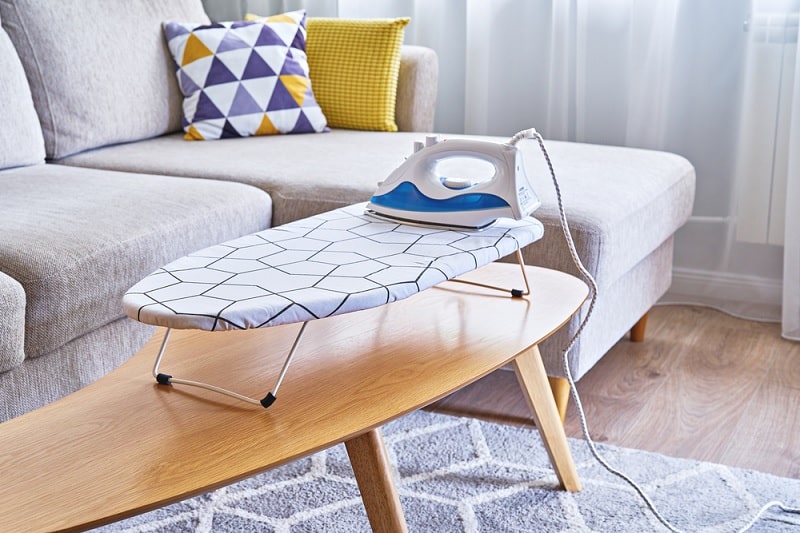
Table-top ironing boards are ideal for people who don’t have a huge amount of space in their homes for a full-size ironing board.
These trendy home additions are also very cute to look at, and are so easy to use because they can sit on top of a table, even a coffee table(!).
Table-top ironing boards can be picked up fairly cheaply and because of their size, they can be stored away with very little effort.
The only downside is, these boards are so small it would take an age for you to iron larger items, think bedding. But if you persevere, you will get there in the end.
Built-in/wall-mounted ironing boards
A built-in/wall-mounted ironing board is an ironing board that is typically tucked away in a cupboard, so it’s not seen around the home.
This is a great option for those who lack space in their home. However, these ironing boards need to be installed by someone, they’re not always height adjustable and they’re usually more expensive.
Handheld steamers
Handheld steamers are used to steam clothes instead of ironing them. These steamers can be bought in many stores for a reasonable price too, plus you can travel with them, which is pretty cool!
The options above are good substitutes for an ironing board, and all have their perks.
What’s the Best Ironing Board?
There isn’t really one answer, because individual preference plays such a huge role when it comes to choosing an ironing board.
To get you started check out our article on the best ironing boards in the UK to see what board suits you.
Conclusion
Ironing boards come in 5 standard sizes in the UK, and it’s important that you think about yourself and your ironing habits before you purchase a board.
FAQs
What’s the difference between a pull-out and built-in/wall-mounted ironing board?
A pull-out ironing board is a traditional ironing board, whereby you have to pull the legs down to get the board to stand up. They’ve been around for years and can be bought in most supermarkets today.
They can vary in price and can be quite heavy to move around. That being said, a lot of other people like this type of ironing board because it can be moved around the home with ease.
On the other side, you have a built-in/wall-mounted ironing board. This type of ironing board is a great space-safer, but it’s usually more expensive to buy and install. This type of ironing board is usually stored in a purpose-built cabinet.
Do you have to use a cover on an ironing board?
It’s worth investing in an ironing board cover before you start to iron clothes on your ironing board.
You need to find a tight fighting cover that will fit snugly on your board. If you leave an old and lumpy cover on your ironing board you won’t be able to iron out the creases in your clothes as well.
How high is my traditional ironing board supposed to be?
A comfortable height to have an ironing board is at hip height.

Bethan has a passion for exploring, reading, cooking and gardening! When she’s not creating culinary delights for her family, she’s concocting potions to keep her house clean!
